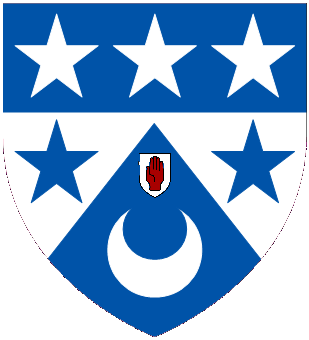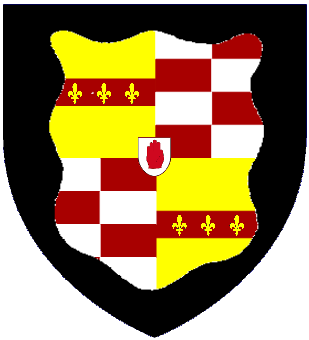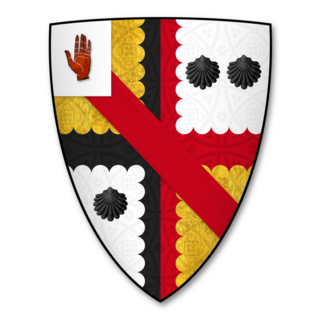
Viscount Hardinge, of Lahore and of Kings Newton in the County of Derby, is a title in the Peerage of the United Kingdom. It was created in 1846 for the soldier and Tory politician Sir Henry Hardinge. His son, the second Viscount, represented Downpatrick in Parliament. His great-great-grandson, the sixth Viscount, succeeded a distant relative as eighth Baronet, of Belle Isle in the County of Fermanagh, in 1986. This title had been created in the Baronetage of the United Kingdom 1801 for Richard Hardinge. He was the third son of Nicolas Hardinge, younger brother of Reverend Henry Hardinge and uncle of the latter's third son Henry Hardinge, 1st Viscount Hardinge. The baronetcy was created with special remainder to the heirs male of Richard Hardinge's father.

Baron Avebury, of Avebury in the County of Wiltshire, is a title in the Peerage of the United Kingdom. It was created 22 January 1900 for the banker, politician and archaeologist Sir John Lubbock, 4th Baronet. He was succeeded by his eldest son, the second Baron. On his death the titles passed to his nephew, the third Baron. He was the son of Harold Fox Pitt Lubbock, fourth son of the first Baron, who died in 1971. The title then passed to the third Baron's first cousin, the fourth Baron, the son of Maurice Fox Pitt Lubbock, sixth son of the first Baron. The fourth baron was a Liberal Democrat politician and one of the ninety excepted hereditary peers who remained in the House of Lords after the passing of the House of Lords Act 1999. He was succeeded by his son, the fifth Baron, in 2016.

The Arnott Baronetcy, of Woodlands in the Parish of St Anne, Shandon in the County of Cork, is a title in the Baronetage of the United Kingdom. It was created on 12 February 1896 for the Irish entrepreneur and philanthropist John Arnott.

The Austin Baronetcy, of Red Hill in the parish of Castleford in the West Riding of the County of York, is a title in the Baronetage of the United Kingdom. It was created on 16 July 1894 for John Austin, Liberal member of parliament for Osgoldcross.

The Barrett-Lennard Baronetcy, of Belhus in the County of Essex, is a title in the Baronetage of the United Kingdom. It was created on 30 June 1801 for Thomas Barrett-Lennard, subsequently Member of Parliament for Essex South. He was the illegitimate son and testamentary heir of Thomas Barrett-Lennard, 17th Baron Dacre. He was succeeded by his grandson, the second Baronet, the son of Thomas Barrett-Lennard, Member of Parliament for Maldon. His son, the third Baronet, was childless and was succeeded by his younger brother, the fourth Baronet. This line of the family failed on the death in 1977 of his son, the fifth Baronet, who died without male issue. The late Baronet was succeeded by his third cousin once removed, the sixth Baronet. He was the son of Sir Fiennes Cecil Arthur Barrett-Lennard, Chief Justice of Jamaica, son of Captain Thomas George Barrett-Lennard, son of the first marriage of George Barrett-Lennard, son of John Barrett-Lennard, second son of the first Baronet. The sixth Baronet was a Catholic clergyman. As of 2014 the title is held by his second cousin, the seventh Baronet, who succeeded in 2007. He is the grandson of Trenchard Barrett-Lennard, son of the aforementioned George Lennard-Barrett by his second marriage. As of 31 December 2013 the present Baronet has not successfully proven his succession and is therefore not on the Official Roll of the Baronetage, with the baronetcy considered vacant since 2007.

The Briscoe Baronetcy, of Bourn Hall, in the Parish of Bourn, in the County of Cambridge, is a title in the Baronetage of the United Kingdom. It was created on 12 July 1910 for John James Briscoe. He was a County Alderman, a Justice of the Peace and Deputy Lieutenant for Cambridgeshire. His eldest son, the second Baronet, died childless and was succeeded by his younger brother, the third Baronet. As of 2023 the title is held by the latter's great-grandson, the sixth Baronet, who succeeded from birth in 1994, his father having died earlier that year.
There have been four baronetcies created for persons with the surname Bell, all in the Baronetage of the United Kingdom. One creation is extant as of 2007.

The Baynes Baronetcy, of Harefield Place in the County of Middlesex, is a title in the Baronetage of the United Kingdom. It was created on 29 June 1801 for Christopher Baynes. He was Major-Commandant of the Uxbridge Gentlemen and Yeomanry Cavalry, which he helped to raise. The title descended from father to son until the death of his great-great-grandson, the fifth Baronet, in 1971. The late Baronet died unmarried and was succeeded by his first cousin, the sixth Baronet. He was the son of Reverend Malcolm Charles Baynes, fourth son of the third Baronet. As of 2023 the title is held by his grandson, the eighth Baronet, who succeeded his father in 2005.

The Wiggin Baronetcy, of Metchley Grange in Harborne in the County of Stafford and of Garth Gwynion in Machynlleth in the County of Montgomery, is a title in the Baronetage of the United Kingdom. It was created on 17 June 1892 for Henry Wiggin. He was the founder of Henry Wiggin and Co Ltd, manufacturers of specialty metal products, and also represented Staffordshire East and Handsworth in the House of Commons. The second Baronet was High Sheriff of Staffordshire in 1896. The third Baronet was a colonel in the army and served as High Sheriff of Warwickshire in 1942. The fourth Baronet was high sheriff of Warwickshire from 1975 to 1976 and a deputy lieutenant of the county in 1985.

The Cotterell baronetcy, of Garnons in the County of Hereford, is a title in the Baronetage of the United Kingdom. It was created on 2 November 1805 for John Cotterell, Member of Parliament for Herefordshire for many years. The third Baronet also represented this constituency in the House of Commons. The fourth Baronet was Lord-Lieutenant of Herefordshire.

The Wedderburn, later Ogilvy-Wedderburn Baronetcy, of Balindean in the County of Perth, is a title in the Baronetage of the United Kingdom created in 1803.

The Fletcher, later Boughey Baronetcy, of Newcastle-under-Lyme and of Betley both in the County of Stafford, is a title in the Baronetage of Great Britain. It was created on 24 August 1798 for Thomas Fletcher, of Betley Court, Staffordshire, High Sheriff of Staffordshire in 1783 and 1789 and Deputy Lieutenant of the county. He was the husband of Elizabeth Fenton, granddaughter of George Boughey, of Audley, Staffordshire whose will provided for his great-grandson to inherit the Audley estate.

The Milman Baronetcy, of Levaton-in-Woodland in the County of Devon, is a title in the Baronetage of Great Britain. It was created on 28 November 1800 for Francis Milman, Physician-in-Ordinary to King George III and President of the Royal College of Physicians. The seventh Baronet was a brigadier-general in the British Army.

The Buckworth, later Buckworth-Herne, later Buckworth-Herne-Soame Baronetcy, of Sheen in the County of Surrey, is a title in the Baronetage of England. It was created on 1 April 1697 for John Buckworth, High Sheriff of London in 1704. The second Baronet sat as Member of Parliament for Weobley. The third Baronet was Assistant Gentleman Usher to George II. The fifth Baronet was Gentleman-Pensioner and Exon of the Guard during the reign of George III. He married Anne, daughter of Paston Herne, of Haveringland Hall, Norfolk, and assumed by Royal licence the additional surname of Herne. The sixth Baronet assumed in 1806 by Royal licence the additional surname of Soame in compliance with the will of Sir Peter Soame, 4th Baronet, of Thurlow. The ninth Baronet was a member of the Shropshire County Council.
There have been three baronetcies created for personswith the surname Elphinstone, two in the Baronetage of Nova Scotia and one in the Baronetage of the United Kingdom. As of 2008 two of the creations are extant while one is dormant.
Sir Clarence Johnston Graham, 1st Baronet was a businessman and an Ulster Unionist Party politician in Northern Ireland.
The Montgomery baronetcy, of Stanhope in the County of Peebles, was created in the Baronetage of the United Kingdom on 16 July 1801 for the Scottish lawyer and politician James Montgomery. The second Baronet represented Peeblesshire in Parliament. The third Baronet represented both Peebles and Peebles and Selkirk in Parliament. He assumed the additional surname of Graham. The seventh Baronet was Lord-Lieutenant of Kinross-shire. He assumed the surname of Purvis-Russell-Montgomery in 1906 and Purvis-Russell-Hamilton-Montgomery in 1933. The eighth and ninth Baronet have used the surname Montgomery only. The ninth Baronet was Lord-Lieutenant of Perth and Kinross.

The Graham baronetcy, of Norton Conyers in the County of York, was created in the Baronetage of England on 17 November 1662, for Richard Graham. He was the second son of the first of the Graham baronets of Esk (1629): the title was in honour of his late father's services to the Royalist cause, recognised after The Restoration of the monarchy.

The Graham Baronetcy, of Netherby in the County of Cumberland, was created in the Baronetage of Great Britain on 15 January 1783 for James Graham. He later represented Ripon in the House of Commons. This branch of the Graham family was connected with William Grahme, fourth son of the 2nd Baronet of the Graham baronets of Esk (1629). James Graham was son of Robert Grahme D.D., son of William Grahme.

The Graham baronetcy, of Larbert House in Larbert and of Househill in Dunipace in the County of Stirling, was created in the Baronetage of the United Kingdom on 4 December 1906 for John Graham, a Glasgow merchant.